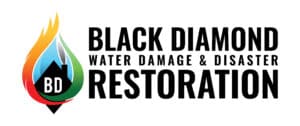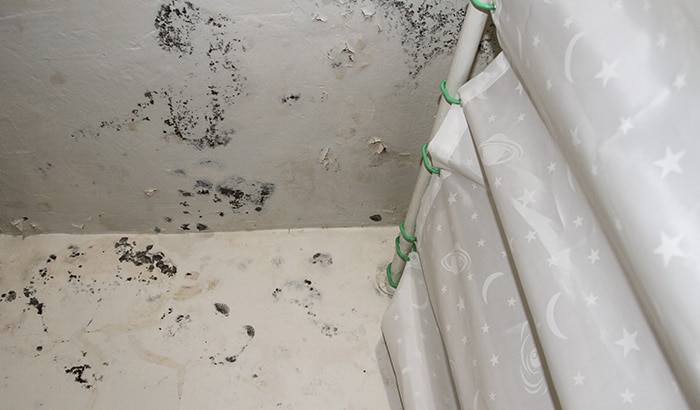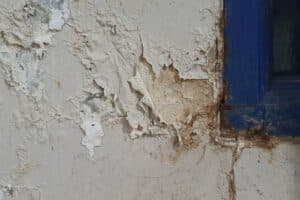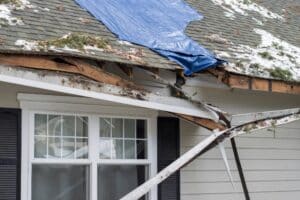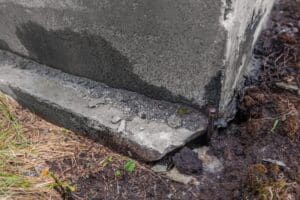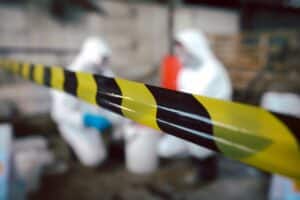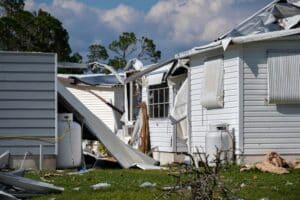Mold remediation is crucial when it comes to mold in your home or business; simply ignoring it won’t make it go away. It’s important to realize that ignoring the problem won’t solve it — instead, it leads to many issues that will worsen if you don’t do something about it.
Prevent mold from becoming a problem in your home by addressing it promptly. If you don’t, here’s what happens when you don’t get rid of mold in your home:
- Health Risks: Ignoring mold growth can lead to various health problems, especially for individuals with allergies, asthma, or weakened immune systems. The spores released by mold cause respiratory issues, persistent coughing, sneezing, and sinus congestion. In some cases, it might even trigger more severe reactions like fungal infections.
- Structural Damage: Mold doesn’t just affect your health; it also damages the very structure of your home. As it feeds on organic materials like wood, drywall, and insulation, it weakens these materials, potentially leading to structural instability over time.
- Odor and Allergens: Mold emits a distinctive musty odor that spreads throughout your home, making your living conditions less pleasant. This odor is particularly difficult to remove, even after the mold has been eradicated. Moreover, mold releases allergens into the air that cause allergic reactions in sensitive individuals.
- Decreased Indoor Air Quality: Mold spores reduce indoor air quality, leading to discomfort, headaches, fatigue, and difficulty concentrating. Poor air quality exacerbates existing health issues and impacts your overall quality of life.
- Rapid Spread: Mold spreads rapidly if left untreated. Air currents easily carry spores and settle them in new areas, creating new growth sites and making them harder to control.
- Contamination of Other Areas: Mold growth in one part of your home easily spreads to other areas through air circulation and cross-contamination. Ignoring mold in one room can lead to its appearance in multiple areas.
- Property Value Decline: The presence of mold issues within your property negatively influences its overall value. Upon encountering signs of mold, prospective buyers often exhibit hesitancy and concerns. Addressing mold problems proactively not only safeguards the value of your property but also fosters a more positive market perception, potentially leading to more favorable outcomes during the selling process.
- Increased Maintenance Costs: If mold continues to grow, the necessary repairs and renovations will become more extensive and costly. Catching mold early will save you money on repairs in the long run.
- Legal and Liability Concerns: Landlords are responsible for providing safe living conditions in rental properties. Neglecting mold issues may even result in legal action, including fines and penalties.
- Financial Strain: Remediation and repairs for extensive mold problems place a considerable financial burden on homeowners. It’s more cost-effective to address the issue as soon as it’s detected.
- Negative Aesthetics: The persistence of mold stains poses a challenge for complete removal, often leaving some residual discoloration despite cleaning efforts. This has a detrimental effect on the aesthetic appeal of surfaces such as walls and ceilings. The enduring discoloration may detract from the overall visual appeal of your living or working spaces, prompting a potential need for additional measures to restore the original appearance.
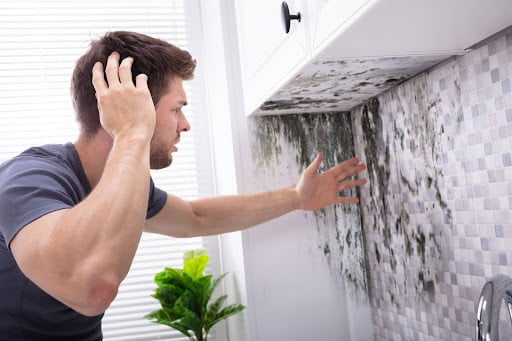
- Personal Belongings at Risk: Mold damages personal belongings like clothing, books, and electronics. Even if these items aren’t visibly affected, mold spores are released, potentially affecting your health.
- Long-Term Health Effects: Prolonged mold exposure leads to more severe health conditions, including fungal infections, chronic respiratory issues, and even neurological problems in rare cases.
- Exacerbation of Existing Conditions: Individuals with allergies or asthma may experience intensified symptoms due to mold exposure, requiring more aggressive treatment and management.
- Chronic Fatigue and Cognitive Impairment: Mold exposure has been linked to chronic fatigue syndrome and cognitive impairments like memory issues, difficulty concentrating, and brain fog.
- Heating and Cooling Efficiency: Mold growth in HVAC systems obstructs proper airflow, making your heating and cooling systems less efficient. This inefficiency increases energy costs and decreases comfort.
- Inhabitability: In severe cases, extensive mold growth renders parts of your home uninhabitable until thorough remediation is completed, disrupting your daily life.
- Insurance Complications: Mold issues lead to disputes with insurance companies, as some policies may not cover mold-related damages or remediation.
- Vulnerable Populations: Mold poses a greater risk to vulnerable populations such as infants, children, the elderly, and individuals with compromised immune systems.
- Emotional Toll: The ongoing struggle of dealing with mold issues, along with concerns about health, finances, and property value, takes a significant emotional toll on homeowners and their families. Anxiety, stress, and a sense of helplessness are common feelings associated with prolonged mold problems.
In order to avoid all the potential problems mentioned above, you’ll want to contact a professional immediately for mold remediation.
When you hire a professional for mold remediation, here’s what to generally expect during the process:
- Initial Assessment: The process begins with a comprehensive assessment of the affected areas. Professionals will inspect visible mold growth, identify the sources of moisture that contributed to the mold, and assess the potential risks to occupants’ health.
- Scope of Work: Based on the assessment, the professionals will develop a detailed plan outlining the scope of the remediation work. This plan will include the areas to be treated, the methods to be used, and the timeline for completion.
- Containment Setup: The experts will establish containment barriers using plastic sheeting and negative air machines to prevent cross-contamination. These barriers isolate the affected area from the rest of the property, ensuring mold spores don’t spread.
- Personal Protective Equipment (PPE): The remediation team will suit up in appropriate PPE, which typically includes gloves, N95 respirator masks, protective eyewear, and possibly disposable coveralls.
- Air Filtration: High-efficiency particulate air (HEPA) filters will capture airborne mold spores and prevent their circulation to other parts of the property.
- Removal of Contaminated Materials: Materials heavily contaminated with mold, such as damaged drywall, insulation, and carpeting, will be carefully removed and double-bagged in heavy plastic for proper disposal.
- Cleaning and Disinfection: Remaining surfaces will undergo thorough cleaning using specialized cleaning agents designed to remove mold growth. HEPA vacuuming might also be used to ensure any loose spores are captured.
- Antifungal Treatment: In some cases, a biocide or antimicrobial treatment might be applied to surfaces after cleaning to hinder future mold growth.
- Drying and Dehumidification: Effective moisture control is essential for preventing mold reinfestation. Professionals may deploy dehumidifiers and fans to ensure the area is adequately dried.
- Verification and Testing: After remediation, the professionals will conduct a final visual inspection to ensure the mold has been effectively removed. In some cases, they might use moisture meters and perform air quality testing to confirm the success of the remediation.
- Post-Remediation Testing: Depending on the extent of the mold issue and local regulations, a third-party inspector might conduct post-remediation testing to validate that mold levels have been reduced to acceptable levels.
- Preventive Measures: Remediation professionals may provide recommendations for preventing future mold growth. This might include addressing issues like improving ventilation, repairing leaks, and maintaining proper humidity levels.
- Documentation: Upon completion, you might receive documentation outlining the work performed, the methods used, and testing results. This documentation is important for insurance claims or property records.
- Reconstruction: If significant building materials were removed during the remediation process, you might need to engage a contractor for reconstruction. This could involve replacing drywall, insulation, or other structural components.
- Clearance Certificate: Once all remediation activities are finalized, and the area has passed testing, you might receive a clearance certificate affirming that the property is safe for reoccupation.
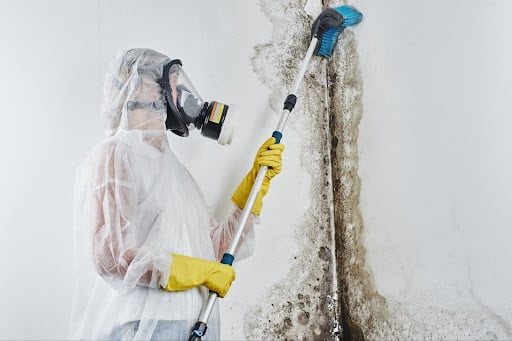
Effective communication between you and the remediation professionals is crucial throughout the process. A back-and-forth flow of information ensures that you are consistently updated on the ongoing progress, any alterations in the plan that might arise, and any requisite precautions that need to be taken to ensure the smooth execution of the remediation process.
By fostering open lines of communication, you establish a collaborative environment that empowers you to remain well-informed, make informed decisions, and actively engage in the process. Moreover, this proactive approach fosters a sense of transparency, trust, and partnership with the remediation experts, ultimately contributing to the efficacy and success of the remediation efforts.
Black Diamond Restoration Is Your Mold Remediation Company
Should you find yourself grappling with a mold issue within your home, time is of the essence. Contact Black Diamond Restoration today for a swift and efficient solution to your mold remediation needs.
Our team of seasoned professionals has the expertise, skills, and cutting-edge equipment to not only eliminate mold but also prevent any further damage with precision.
We pride ourselves on fostering a collaborative partnership with you and your insurance provider, ensuring a seamless, cost-effective, and stress-free remediation process.
The health and security of your family and property are paramount, and with this in mind, we implore you not to leave them to chance. Contact us on our site or call 801-797-2502 to schedule a consultation. By taking this proactive step, you’re safeguarding your home against the potential threats mold poses.
toto slot